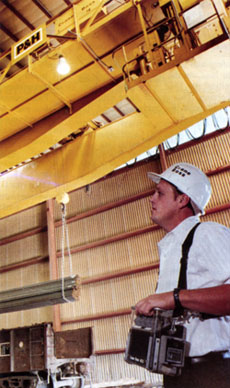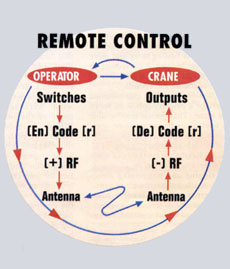Overhead cranes are the workhorses in many service centers. Now, remote control units are making these heavy-lift devices more efficient, with greater freedom of operation. The secret is radio signals.
BY WILLIAM JENNINGS

Crane operation has always had two simply stated objectives: get the crane to the load, then move the load somewhere; and do it safely and efficiently. In the past, crane movements were actuated either by a cab-mounted operator guided by hand signals from a floor walker, or by pushbutton pendants hanging from the crane and controlled by someone on the floor.
Today, a third method has entered the scene: remote control of a crane’s operation, particularly through radio signals (learn about radio vs. infrared), is finding more and more popularity, because it overcomes so many of the practical problems of crane operation and control.
Consider this: The cab-mounted operator’s primary job is to move the crane. That person may be able to work alone managing some operations with below-the-hook attachments, such as magnets, grabs, or C-hooks. But the vast majority of loads requires assistance on the floor both for rigging and positioning direction. Both activities slow crane movement and may involve some safety hazards.
While pendant control solves some of these problems by bringing crane control closer to the load, there are still problems. The pendant is on the wrong side of the crane half the time, even with the convenience of festooning across the bridge. Or the pendant could be dropped from the hoist. Either way, the operator finds that “dodging” the load and untangling the cable become time-consuming and somewhat hazardous parts of the job. While a floor walker directing the operator with hand signals or voice radio simplifies the job, crane movement would still be slowed to the operator’s pace. And a walking aisle must also be available.
Most of these problems are avoided using a remote cordless control because it permits the operator to control the crane’s position from any point on the floor that makes most sense for safety and efficiency – at the left of the load, on the truck, in the railcar, behind the load, or on the rack or shelving. This makes more efficient use of both the operator’s and the crane’s time.
The response time for the remote controller’s electronics, for all practical purposes, is instantaneous.
The Remote Controller
A remote control system consists of a portable transmitter unit that generates control signals, plus receiving equipment permanently installed on the crane and electrically connected to the crane’s motor controllers. Switches on the transmitter control all functions of the crane. Installation may be as a retrofit to an existing crane, or as part of a new construction.
Each switch on the remote controller generates a unique combination of pulses that are transmitted to the crane-mounted receiver via a radio signal or infrared beam. At the crane, the pulse strings are removed from the carrier signal to activate the desired motor controllers. The response time for the electronics, for all practical purposes, is instantaneous.
The receiving equipment cabinet contains circuitry for decoding the radio signal generated by the controller, and drivers that extract the pulse codes from the incoming signal and convert them into signals suitable for the crane’s motor controllers.
The key to the accuracy and reliability of remote controller operation lies entirely in the encode/decode schemes. Only the correct signal (radio frequency or light beam) will be received, and only a recognizable pulse code format will be decoded. The circuits are also designed to guard against he effects of interference or unintentional code generation.
Remote Control Installation

While most crane installations can be adapted to remote cordless conttrol, there are some prerequisites.
The crane must be equipped with magnetic motor controllers, rather than drum controllers, which are typical of many older cab-operated cranes. In addition, the number of motions – how many hoists on how many trolleys, etc. – and the number of speed positions per motion need to be known.
The second requirement is that brakes must be equipped for emergency or parking, and automatically interlocked with existing motor controls.
Hydraulic brakes operated by foot pedal must be converted to allow electrical actuation. Conversion kits are available; remote cordless controls can provide, on a special basis, mu1ti-1eve1 braking in two, three, or more steps if required.
In addition, other auxiliary functions must be equipped for remote actuation; it should never be necessary to sacrifice an auxiliary function control because operation is remote. The auxiliaries might include any of below-the-hook attachments.
Conversion and retrofitting may be done by the service center personnel, or it may be contracted out. The installation should include a switch that will allow transfer of crane control between the cab or pendant system, and the remote controller. In addition to operational flexibility, such an arrangement has the added advantage of protecting against simultaneous control attempts from two sources.
Final check-out should always be under the direction and supervision of the supplier. It is recommended that this cheek-out be performed before any remote cordless control equipment is powered, thus eliminating initial problems which may be encountered by untrained personnel.
Benefits of Remote Cordless Controls
Remote crane control may not be for every situation; the following key areas need to be evaluated.
- Duty cycle: Cranes that are in operation 20% to 80% of the time have an inherent inefficiency in that the cab operator is idle for a great part of his shift. By placing the person on the floor with a remote controller, he or she is available for other duties when the crane is inactive.
Cranes in operation on virtually a 100% basis, will always need a full-time operator. Using a remote cordless controller would be beneficial under such circumstances only if other efficiencies are realized. Conversely, cranes operated only once or twice a day may not justify a remote controller, because an operator could climb to the cab for those few operations. There are, of course, exceptions to this reasoning: long craneways with multiple processing spaced out is one example; in this instance, multiple control transmitters could be plausible. Duties of floor person: If the hooking operation is relatively simple so that one person can operate the crane with a remote controller and also handle the hooking, great benefits are realized. Here, too, if the duty cycle is less than continuous, a remote control unit makes it possible for the floor person to perform other duties between cycles. - Visibility: Can the operator see from the cab or handle rigging from the pendant location? Are voice and hand signals needed? If so, a remote cordless controller can improve efficiency by eliminating such intermediaries. Crane operation will be faster, and manpower savings are realized if a relay person/rigger can be reassigned.
- Materials being handled: Are the items being moved expensive: finished products such as steel rolls or dies? Can inaccurate hooking and spotting damage the materials? If so, the cordless control unit will put the operator up close where the person can be most accurate and cause least damage.
- Location of cab: Must the cab be positioned in hot areas or over such dangerous locations as soaking pits, or tilting ladles? Can the crane be operated from a safer location? If heat is the problem, will operating the crane from a remote location eliminate need for air conditioning?
- Use of materials or machines: Are men and machines dependent upon operation of the crane; must they frequently wait for an operator? If so, will use of a remote controller eliminate the tie up?
- How many cranes are in the location? A multiple-crane access-control transmitter can allow one operator to “roam” between two or more cranes, perhaps with instructions via voice radio.
Increased accuracy in spotting loads speeds operations, reduces damage to materials.
- “Pitch and catch” operations: Loading or unloading of trucks or machines from stocking racks in storage bays can be expedited by a controller team. One man at the truck or machine, and another roaming the bay, both equipped with control transmitters, can hook up (pitch) and unhook (catch) loads over long distances at cab crane speeds – far above walking speed. Each operator would have access only when the other relinquishes control.
Where remote cordless crane control is justified, there are additional benefits to be had. Because the operator can be in an optimum location on the floor, he or she can see and be part of the hooking and spotting operation, avoiding the inefficiencies of voice and hand signals. The operator need not waste the time climbing to the cab. The result is more lifts per hour.
Faster servicing of operations is possible because the crane is called from the point demanding service. Optimum crane movement is planned before the unit is even activated.
Better utilization of floor space is possible than with either an operator in the cab or an operator with a pendant. With the cab-mounted control, an operator needs more room because he can’t be as accurate in positioning; with the pendant, the operator requires more floor space in order to walk along with the crane.
Increased accuracy in spotting loads yields not only more speed for a given operation, but also reduces damage to materials.
Some Myths Debunked
The use of delicate electronics in industrial environments, even in areas where high-power and high-voltage circuits are used, is now commonplace. Decades of experience and ensuing technical developments have made the needed physical and electrical isolations possible, allowing all manner of electrical and electronic devices to function side by side. Further, electronic devices today are packaged in rugged housings that protect them against the physical rigors of their operating environments – heat, cold, heavy-handed use, explosive atmospheres, etc.
What is the Government’s Role – Briefly
The federal government, through the Federal Communications Commission (FCC), controls the use of all radio receivers and transmitters in the country. The FCC’s regulations provide frequencies for a variety of uses – broadcast, various emergency services such as police and fire departments, and industrial uses – and specify the amount of power that may be used in each of the applications. Based on the FCC’s provisions, it would be possible to operate over 250 cranes within the same facility.
A typical installation requires one radio frequency channel per transmitter, and one access code per crane.
Obviously, this is well beyond the needs of any plant, but it emphasizes the fact that there is virtually unlimited capacity in any local geographical area. A typical installation requires one radio frequency channel per transmitter and one access code per crane; each function has its unique pulse code string.
Two or more cranes can share a radio frequency, provided the units are adequately separated physically to avoid the possibility of receiver “capture” by a co-channel operator. Each crane’s access code will protect against false or uncommanded operation of course, but capture could prevent the unintended crane from receiving signals directed to it.
For most installations, this is more of a potential problem than a real one. All remote cordless controllers operate at the same output power, as specified by the FCC. Therefore, as long as the crane operator is closer to his crane receiver than any other operator sharing his radio channel, he will most likely always maintain secure and positive control of his crane.
There are several coordinating agencies that can help you select the best frequency for your location – one that will not interfere with other properly licensed installations. The National Association of Business and Educational Radio (NABER, for Business Radio Service), the Manufacturers Radio Frequency Advisory Committee (MRFAC, for Manufacturers Radio Service), and the Utilities Telecommunications Coordinator (UTC, for Power Radio Service), are the primary ones.
Licensing is highly recommended especially in metropolitan areas, and particularly for the very busy UHF band. The procedure is simple: the remote cordless control supplier provides filled-out forms.
Perhaps a more frustrating interference problem comes from electrical and electronic devices within the plant. Any such device emits electromagnetic radiation – it might be static, or it may be something more pernicious. Among the most common interference culprits are motors, welders, computers, and numerical control equipment.
While most remote cordless controllers designed for industrial use are well engineered to recognize only what they expect to see (the proper code signal), extreme interference problems can cause “dropouts” which actually cause all motions to stop.
In summary, wireless remote crane control systems may not offer sufficient benefit to justify retrofitting some crane installations. However, most crane operations can benefit from improved efficiency and cost-effectiveness offered by remote controllers.
Reprinted from December issue of METAL CENTER NEWS © Chilton Publications all rights reserved.

